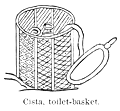Cista, Cistella
(
κίστη, κιστίς).
1.
Originally a wicker basket used for holding vegetables and
 |
|
Cista, votingbasket.
|
other produce (
Plin. H. N. xv.
60), and of either square or cylindrical shape.
2.
A ballot-box, into which the voters cast their
tabellae, and of which
the form and general appearance are shown in the annexed illustration taken from a coin of
the gens Cassia. It is to be carefully distinguished from the
sitella,
the urn from which the names of the tribes or centuries were drawn by lot. (See
Comitia.)
3.
Any box or casket, usually of small size, and intended for almost any purpose—e.
g. a book-box (=
capsa), a jewel-case, a toilet-box. Of the last-named
variety of
cista, a great many very beautiful specimens have been found
of basketwork. They appear to have been used largely for holding hair-pins, sponges, small
mirrors, and scent-bottles. Most of them have been discovered in the southern part of Italy
(Magna Graecia); fewer in Greece proper and in Etruria. The
 |
|
Cista, toilet-basket.
|
metal
cistae (bronze or silver), on the other hand, come
almost exclusively from Praenesté, where they were produced on a large scale. The
most beautiful of these and the first to be discovered
(about the year 1737) is
the celebrated Ficoroni
cista, now in the Museo Kircheriano at Rome. In
1866, Schoene described seventy
cistae from Praenesté alone.
In 1882, Fernique reported the number as having reached one hundred.
4.
The name
cistae was also given to the small boxes carried in the
processions at the Greek festivals of Demeter and Dionysus, and containing the sacred things
connected with the worship of the deities. (See
Catull. lxiv.
259.) The shape was sometimes oblong; oftener cylindrical. To distinguish these from
the common
cistae, they are generally called
cistae
mysticae. See
Cistophorus;
Mysteria.






